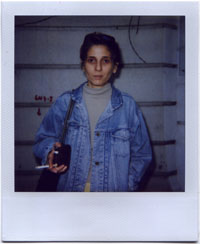Cristina Passima
Interview with Cristina Passima
Cristina Passima is 39 years old. Marilena introduced us to her in front of
the Gallery Noua. Over the past few years Cristina has been working on urbanism.
- Is there a context for contemporary art in Romania?
 Contemporary
art is not highly valued in Romania. There is not much discussion about it,
and it is difficult to convince someone in the public space that contemporary
art is important or to find funding for your projects. I know this from my personal
experience, because I'm facing great difficulties in realizing my projects.
Bucharest is too closed a city to accept this. Here the commercial rules. Most
artists working in contemporary art think that if more public and private funds
are devoted to contemporary art this would help also commercial art. The commercial
can come closer to the art, it should not be the opposite. There are no public
places in Bucharest presenting non-commercial projects and artistic experiments.
Contemporary
art is not highly valued in Romania. There is not much discussion about it,
and it is difficult to convince someone in the public space that contemporary
art is important or to find funding for your projects. I know this from my personal
experience, because I'm facing great difficulties in realizing my projects.
Bucharest is too closed a city to accept this. Here the commercial rules. Most
artists working in contemporary art think that if more public and private funds
are devoted to contemporary art this would help also commercial art. The commercial
can come closer to the art, it should not be the opposite. There are no public
places in Bucharest presenting non-commercial projects and artistic experiments.
- Have you felt pressure from the art circles and the cultural institutions
as a woman artist?
At the moment, things are equally difficult for men and women. I don't know
if I can permit myself to say that men are machists. The key positions in the
institutions are occupied by men, who could help in this situation, but apparently
they are not interested in all this. Perhaps their interests go in another direction.
And from this point of view, overall women are much more active and organized
that the men, in looking for opportunities to realize their projects, in supporting
each other. When I was looking for funding for my own projects, I have received
negative answers more often from men, not so much from women. At the moment
I am preparing a large exhibition which will be financed exclusively by commercial
companies. I see this as a personal success. The idea of what I'm working on
is to fight against advertising with the full range of forms of expression.
- According to an English curator and critic, it is an opportunistic idea
for the state to fund culture.
I cannot imagine that the citizens and the mayor would not want the city to
look more beautiful. In a period in which the city is changing so fast and it's
impossible to imagine what it will look like in ten years, the question is not
about cosmetic aspects of the changes, but about the overall structure of the
city. It seems appropriate to me to work on ideas about urban space. In this
process, it seems to me that the things I do are not accidental objects. They
call the attention of citizens to places in the city that are important, even
though they are not visible on the surface.
Gentrification influences the structure of large cities. This has a bearing
on the lower levels of culture, and we have to be very careful how the city
will develop, and at the same time to maintain its specific spiritual character.
Here in Bucharest we can see many places in which architects have pasted new
buildings in streets like fillings in a mouth. It's very important in a large
city to maintain a distance between human beings and these buildings, to ensure
that the city can breathe.
These questions have constantly been on my mind over the past few years. I
am looking for possibilities to get out of my studio and into urban space.
Dimitrina Sevova - In Someone Else's Skin (2001)
Index of the Interviews
 Contemporary
art is not highly valued in Romania. There is not much discussion about it,
and it is difficult to convince someone in the public space that contemporary
art is important or to find funding for your projects. I know this from my personal
experience, because I'm facing great difficulties in realizing my projects.
Bucharest is too closed a city to accept this. Here the commercial rules. Most
artists working in contemporary art think that if more public and private funds
are devoted to contemporary art this would help also commercial art. The commercial
can come closer to the art, it should not be the opposite. There are no public
places in Bucharest presenting non-commercial projects and artistic experiments.
Contemporary
art is not highly valued in Romania. There is not much discussion about it,
and it is difficult to convince someone in the public space that contemporary
art is important or to find funding for your projects. I know this from my personal
experience, because I'm facing great difficulties in realizing my projects.
Bucharest is too closed a city to accept this. Here the commercial rules. Most
artists working in contemporary art think that if more public and private funds
are devoted to contemporary art this would help also commercial art. The commercial
can come closer to the art, it should not be the opposite. There are no public
places in Bucharest presenting non-commercial projects and artistic experiments.